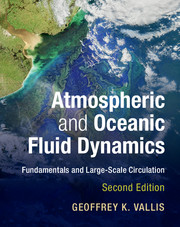Book contents
- Frontmatter
- Dedication
- Contents
- Preface
- Notation
- PART I FUNDAMENTALS OF GEOPHYSICAL FLUID DYNAMICS
- PART II WAVES, INSTABILITIES AND TURBULENCE
- PART III LARGE-SCALE ATMOSPHERIC CIRCULATION
- 14 The Overturning Circulation: Hadley and Ferrel Cells
- 15 Zonally-Averaged Mid-Latitude Atmospheric Circulation
- 16 Planetary Waves and Zonal Asymmetries
- 17 The Stratosphere
- 18 Water Vapour and the Tropical Atmosphere
- PART IV LARGE-SCALE OCEANIC CIRCULATION
- References
- Index
18 - Water Vapour and the Tropical Atmosphere
from PART III - LARGE-SCALE ATMOSPHERIC CIRCULATION
Published online by Cambridge University Press: 09 June 2017
- Frontmatter
- Dedication
- Contents
- Preface
- Notation
- PART I FUNDAMENTALS OF GEOPHYSICAL FLUID DYNAMICS
- PART II WAVES, INSTABILITIES AND TURBULENCE
- PART III LARGE-SCALE ATMOSPHERIC CIRCULATION
- 14 The Overturning Circulation: Hadley and Ferrel Cells
- 15 Zonally-Averaged Mid-Latitude Atmospheric Circulation
- 16 Planetary Waves and Zonal Asymmetries
- 17 The Stratosphere
- 18 Water Vapour and the Tropical Atmosphere
- PART IV LARGE-SCALE OCEANIC CIRCULATION
- References
- Index
Summary
WATER IS AN ORDINARY SUBSTANCE WITH EXTRAORDINARY EFFECTS. The most obvious is that oceans themselves are made of water, and if our planet were dry this book would perforce be much shorter (if only). Leaving aside the dynamical effects of the oceans, water covers over two-thirds of Earth's surface and because it is warm in some places and cold in others, and because the atmosphere is in motion, water evaporates into the atmosphere in one place and condenses from it elsewhere. The condensation leads to rain, one of the most talked-about aspects of weather and climate. Water also freezes to form ice, so that at any given time water exists on Earth in all three phases. Radiatively, water vapour is a greenhouse gas, meaning that it absorbs infrared radiation that might otherwise be lost to space and so maintains the surface of the planet at a temperature over 20 K higher than an equivalent dry planet. Dynamically, the condensation of water vapour in the atmosphere releases energy, warming the air and tending to make it more unstable than otherwise and leading to convection. Further, the net transport of water vapour from low to high latitudes is effectively a meridional transport of energy.
In this chapter we focus on a small number of these issues, mainly on the kinematics and dynamics of water vapour itself and on some aspects of the dynamics of the tropical atmosphere, where the effects of water vapour are most manifest. The tropics would certainly differ from the mid-latitudes even if the atmosphere were dry — its Coriolis parameter is small among other things — so our attention there is by no means confined to the effects of water vapour. Nevertheless, tropical convection and the attendant ‘radiative-convective equilibrium’ are greatly influenced by the presence of water. We begin with a discussion of the thermodynamic properties of water vapour itself. We then move on to an essentially kinematic description of the factors determining the large scale distribution of relative humidity, before finally looking at convection and at tropical dynamics more generally.
A MOIST IDEAL GAS
Water is the compound of hydrogen and oxygen with the chemical formula H2O, although in informal conversation water is often understood to mean only the liquid form of the compound. Water vapour is a gas made up of molecules of H2O, and ice is the solid form of water.
- Type
- Chapter
- Information
- Atmospheric and Oceanic Fluid DynamicsFundamentals and Large-Scale Circulation, pp. 673 - 728Publisher: Cambridge University PressPrint publication year: 2017



